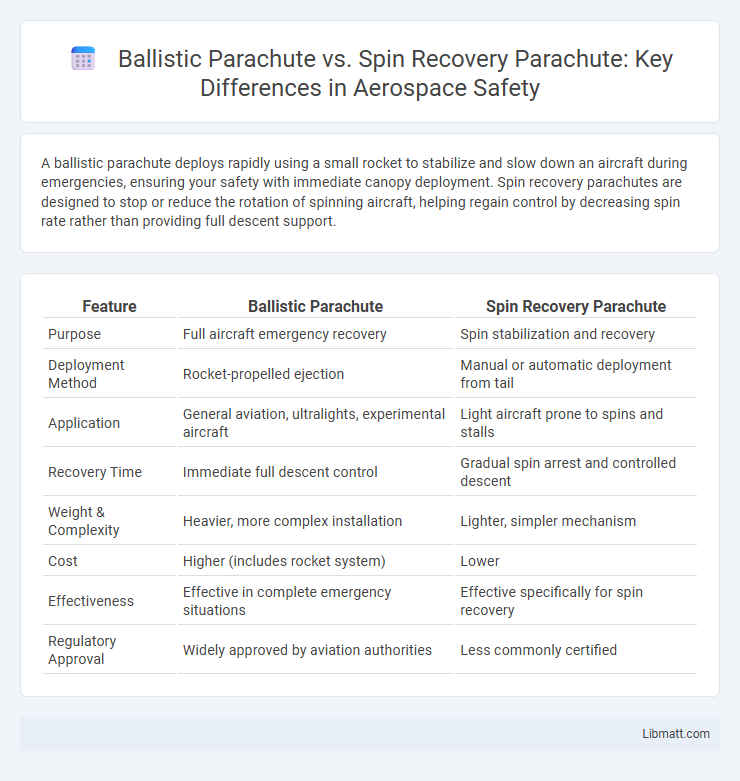A ballistic parachute deploys rapidly using a small rocket to stabilize and slow down an aircraft during emergencies, ensuring your safety with immediate canopy deployment. Spin recovery parachutes are designed to stop or reduce the rotation of spinning aircraft, helping regain control by decreasing spin rate rather than providing full descent support.
Table of Comparison
| Feature | Ballistic Parachute | Spin Recovery Parachute |
|---|---|---|
| Purpose | Full aircraft emergency recovery | Spin stabilization and recovery |
| Deployment Method | Rocket-propelled ejection | Manual or automatic deployment from tail |
| Application | General aviation, ultralights, experimental aircraft | Light aircraft prone to spins and stalls |
| Recovery Time | Immediate full descent control | Gradual spin arrest and controlled descent |
| Weight & Complexity | Heavier, more complex installation | Lighter, simpler mechanism |
| Cost | Higher (includes rocket system) | Lower |
| Effectiveness | Effective in complete emergency situations | Effective specifically for spin recovery |
| Regulatory Approval | Widely approved by aviation authorities | Less commonly certified |
Introduction to Aircraft Emergency Parachutes
Aircraft emergency parachutes, including ballistic parachutes and spin recovery parachutes, provide critical safety measures to pilots during in-flight emergencies. Ballistic parachutes deploy rapidly using a rocket motor to slow the entire aircraft's descent, enhancing survival chances during catastrophic failures. Spin recovery parachutes specifically stabilize and recover aircraft from dangerous spins by deploying a smaller canopy to arrest rotation and restore controlled flight.
What is a Ballistic Parachute?
A Ballistic Parachute is an emergency recovery system designed to rapidly deploy a parachute for an entire aircraft using a small rocket or ballistic device. This system provides an immediate and reliable means to stabilize and safely bring down the aircraft during in-flight emergencies, minimizing pilot and passenger risk. Your safety is enhanced by the quick activation and deployment speed compared to traditional parachutes like spin recovery parachutes.
What is a Spin Recovery Parachute?
A Spin Recovery Parachute is a specialized safety device designed to arrest an aircraft's spin by deploying a small parachute, which stabilizes and helps regain control during an aerodynamic spin. Unlike a Ballistic Parachute, which is deployed externally to bring the entire aircraft safely to the ground in emergencies, the Spin Recovery Parachute targets the specific flight condition of a spin to correct maneuverability issues mid-air. Your understanding of this distinction is crucial for pilots when selecting the appropriate emergency equipment for spin-prone aircraft.
Primary Purpose and Use Cases
Ballistic parachutes are designed primarily for entire aircraft recovery during emergencies such as engine failure or structural damage, rapidly deploying a canopy to safely lower the aircraft to the ground. Spin recovery parachutes specifically target aircraft experiencing uncontrollable spins, stabilizing and slowing the rotation to help pilots regain control. While ballistic parachutes serve as a last-resort safety system for total aircraft descent, spin recovery parachutes are crucial tools for spin prevention and pilot training in aerobatic and light aircraft.
Deployment Mechanisms Compared
Ballistic parachutes deploy rapidly using a rocket-propelled extraction system, ensuring immediate canopy inflation for critical emergency scenarios. Spin recovery parachutes rely on aerodynamic forces to engage, typically deploying after a stabilizing drogue chute slows the aircraft's rotation. Your choice depends on whether you need instantaneous deployment from a catastrophic event or a controlled deceleration to recover from a spin.
Installation and Integration Considerations
Ballistic parachutes require precise integration with the aircraft's structure to ensure rapid deployment and effectiveness during emergencies, often involving reinforced mounting points and dedicated rocket systems. Spin recovery parachutes demand careful installation in the tail area, tailored to the aircraft's airflow patterns, and must be integrated with the control systems for reliable activation during spin conditions. Your choice between these systems hinges on compatibility with your aircraft's design, ease of installation, and the specific emergency scenarios you intend to address.
Effectiveness in Emergency Situations
Ballistic parachutes deploy rapidly using a rocket ejection system, providing immediate canopy coverage crucial for fast stabilization during in-flight emergencies. Spin recovery parachutes specifically target rotational instability by slowing or arresting the aircraft's spin, enhancing control and allowing more time for pilot recovery. While ballistic parachutes maximize overall survivability in diverse emergency scenarios, spin recovery parachutes excel in preventing loss of control due to spins, making their effectiveness situation-dependent.
Safety Benefits and Limitations
Ballistic parachutes provide rapid deployment and reliable descent control during emergencies, significantly enhancing pilot and passenger safety by reducing impact forces in otherwise fatal situations. Spin recovery parachutes specialize in mitigating uncontrolled spins by stabilizing the aircraft's rotation, but their effectiveness depends on altitude and aircraft compatibility, limiting use cases. Both systems improve overall flight safety, yet ballistic parachutes offer broader emergency protection while spin recovery parachutes serve as advanced control aids in specific aerodynamic failures.
Cost Factors and Maintenance
Ballistic parachutes typically incur higher upfront costs due to advanced deployment mechanisms and integrated rocket systems, while spin recovery parachutes often present a more economical initial investment but may require specialized maintenance to ensure reliability. Maintenance for ballistic parachutes involves routine inspections of rocket canisters and triggered deployment components, generally resulting in higher ongoing expenses compared to the simpler fabric and suspension lines checks needed for spin recovery parachutes. Cost factors also include the frequency of repacking and replacement parts, with ballistic systems demanding more frequent professional servicing to maintain FAA compliance and operational readiness.
Choosing the Right Parachute for Your Aircraft
Choosing the right parachute for your aircraft depends on factors such as aircraft size, weight, and flight envelope. Ballistic parachutes deploy rapidly using a rocket mechanism, making them ideal for emergencies requiring immediate descent, while spin recovery parachutes stabilize and slow aircraft rotating out of control. Understanding your aircraft's typical flight conditions and potential failure modes ensures optimal selection between ballistic and spin recovery parachutes for enhanced safety.
Ballistic Parachute vs Spin Recovery Parachute Infographic

 libmatt.com
libmatt.com